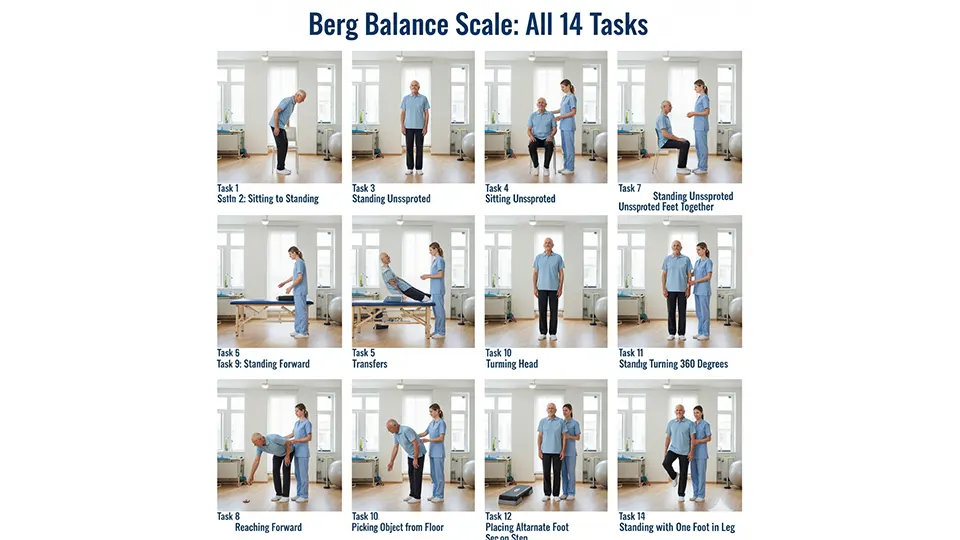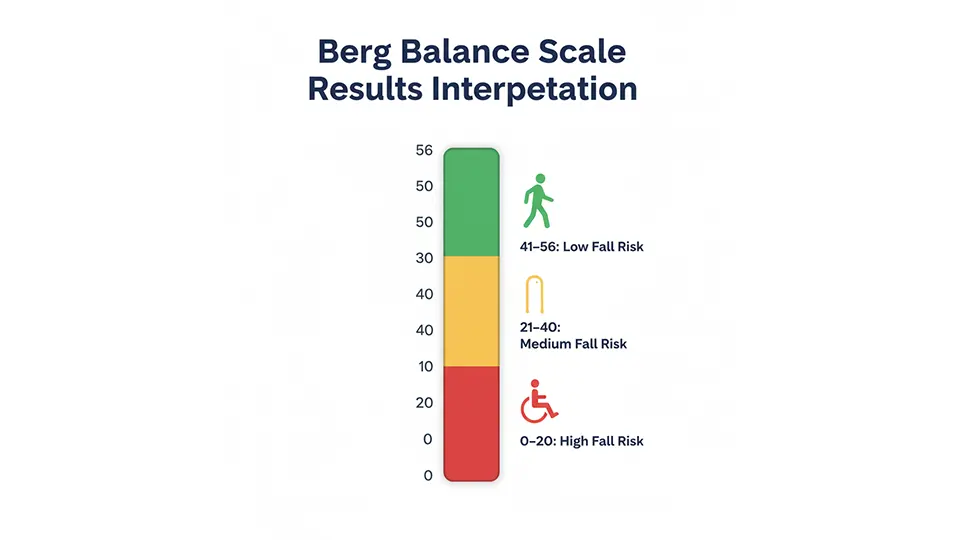Berg Balance Scale Online Calculator | Free Physiotherapy digital Tool
Table of Contents
What is the Berg Balance Scale (BBS)?
The Berg Balance Scale online calculator is one of the most widely used clinical tools to measure balance and fall risk. It is a gold-standard clinical test widely used by physiotherapists, occupational therapists, and rehabilitation specialists across the USA, UK, Canada, and Europe. It consists of 14 everyday tasks that measure balance and stability, each scored from 0 to 4.
The highest possible score is 56. Lower scores suggest higher risk of falling. This tool is trusted globally for assessing balance in:
Older adults
Stroke survivors
Neurological patients (Parkinson’s, MS)
Post-surgical rehabilitation patients

This free online calculator allows physiotherapists, patients, and students to complete the assessment digitally, without needing paper forms.
How to Use the Berg Balance Scale Digital Tool
- Read each of the 14 tasks carefully.
- Select a score from 0 (unable to perform) to 4 (normal performance).
- The tool will automatically calculate the total score.
- View your result instantly along with a fall risk interpretation.
- Download a PDF report for records or to share with a physiotherapist.

Scoring & Interpretation
- 41–56 points: Low fall risk – independent in daily activities.
- 21–40 points: Medium fall risk – requires some supervision/assistance.
- 0–20 points: High fall risk – significant balance impairment, needs support.

⚠️ Disclaimer: This tool is for educational use only. Always consult a licensed physiotherapist for medical advice.
Why Use Our Berg Balance Scale Online Calculator?
- ✅ Free & easy to use
- ✅ Instant results with interpretation
- ✅ Downloadable PDF report
- ✅ Accessible on any device (mobile-friendly)
- ✅ Designed by physiotherapy experts
Here is Berg Balance Scale Online Calculator
FREQUENTLY ASKED QUESTION ABOUT BERG BALANCE SCALE DIGITAL TOOL
Who should use the Berg Balance Scale?
The BBS is mainly used for older adults, stroke patients, and anyone with balance issues. Physiotherapists also use it to track rehabilitation progress.
Is this tool accurate?
Yes, it follows the official Berg Balance Scale guidelines. However, results should be interpreted by a healthcare professional.
Can I use it at home?
You can, but it is safest to perform the test under the guidance of a physiotherapist to avoid falls during tasks.
How long does it take to complete the Berg Balance Scale?
On average, it takes 15–20 minutes to complete all 14 tasks of the test.
Who can administer the Berg Balance Scale?
It is typically performed by a physiotherapist or healthcare professional, but patients and caregivers can also use this digital tool under guidance.
Is the Berg Balance Scale valid and reliable?
Yes. Research shows that the BBS is a highly reliable and validated tool for assessing balance in clinical and community settings.
Can I use this tool at home without a physiotherapist?
Yes, you can try it at home with help from a caregiver, but some tasks may pose a fall risk. It’s best to use the tool under professional supervision.
What does a score of 45 on the Berg Balance Scale mean?
A score of 41–56 is considered low fall risk. A score of 45 suggests good balance, but it’s still important to monitor progress and stay active.
What conditions is the Berg Balance Scale useful for?
It is commonly used in patients with:
Stroke
Parkinson’s disease
Multiple sclerosis
Post-surgical rehabilitation
Elderly individuals with fall risk
What is the maximum score on the Berg Balance Scale?
The highest possible score is 56, which indicates normal balance.
Is the Berg Balance Scale the same as a fall risk assessment?
The BBS is one of the most widely used fall risk assessments, but there are also other tools like the Tinetti Balance Test and Timed Up & Go (TUG) test.
How often should the Berg Balance Scale be repeated?
Physiotherapists often repeat the test every few weeks during rehabilitation to track progress and improvements in balance.